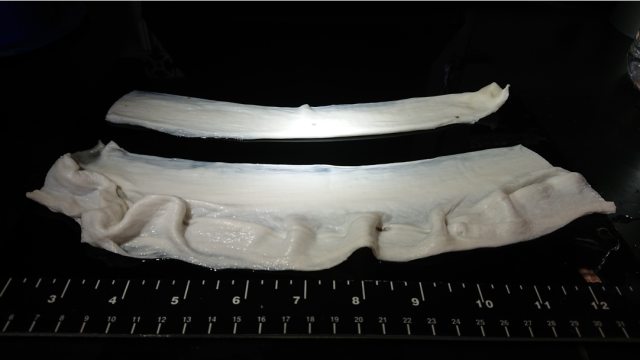Synthetic meat products might come even closer to the texture of slaughtered meats with the help of what are essentially modified cotton candy machines.
Scientists at universities and private companies are attempting to recreate the flavour and texture of animal-based meats using similar techniques to those used in biomedical labs. But plant-based meat analogs on the market, like the Impossible Burger and the Beyond Burger, generally come in mushy patties or sausage links, whose textures are rather easy to mimic. Perhaps gelatin-based fibres will allow researchers to create something closer to, say, a steak.
“We think we’ve cracked one of the biggest nuts in the synthetic food industry,” Kevin Kit Parker, study author and professor of bioengineering and applied physics at Harvard, told Gizmodo.
The team has previously produced tiny synthetic fibres using a system similar to a cotton candy machine, though their machine spins much faster. For this study, they wanted to see if they could use gelatin to produce those fibres, and in turn, whether those fibres would be able to serve as scaffolding for muscle tissue to produce meat of a more realistic texture.
Meat is more than just a messy agglomeration of fat and protein — it’s a variety of cells of different types that make up tissue, linked together in ways that produce a pleasant texture and flavour given enough added heat.
Sure, plant-based meat companies have gotten the ground-up meat texture down pretty well, but hamburgers and sausages are only part of the vast array of meat dishes eaten for millennia by cultures across the world. Mimicking these more complex structures is a challenge and represents a potential hurdle for those hoping to replace the meat in their diets with slaughter-free alternatives.
The team tested various concentrations of gelatin and was able to create fibres of controllable diameter, based on the machine’s settings. They turned the gelatin fibre into a scaffolding and attempted to grow rabbit and cow cells in culture and have them latch onto the fibre. Both cell types latched on and grew into the spaces between the fibres, aligning based on the lengths of the fibres. For those who take issue with gelatin, which is made from animals parts, the team’s past research demonstrated that they could make these edible scaffolds from other molecules as well.
How meaty was it? Well, according to the paper published in Science of Food, it lacked some of the shape of the muscle, looking more like fish balls or ground beef. The researchers performed a preliminary analysis to determine the texture compared to other meats (they couldn’t just eat it, per lab safety protocols) and determined that, well, their creation is similar but is still missing some of the springiness that an animal muscle provides. There’s a lot more work to do, study author Luke MacQueen from Harvard said in a press release; the meat texture has yet to be fully recreated.
I reached out to a handful of cultured meat companies to see how the research compared to industry progress on this front. Mike Selden, co-founder and CEO of cultured fish startup Finless Foods, confirmed to Gizmodo that lots of folks in the cellular agriculture industry are exploring the use of these spun microfibres and that they have the potential to be a very important technology. Kate Krueger, research director at New Harvest, said that the work showed “great promise” in the area of scaffolding material.
Parker told Gizmodo that he has more in mind than lab-grown meat products. Perhaps this could be used to produce custom meats or healthier meats, with beef fat replaced with fish fat, for example. He confirmed that his group plans to create company based on the technologies they’ve been working on.
